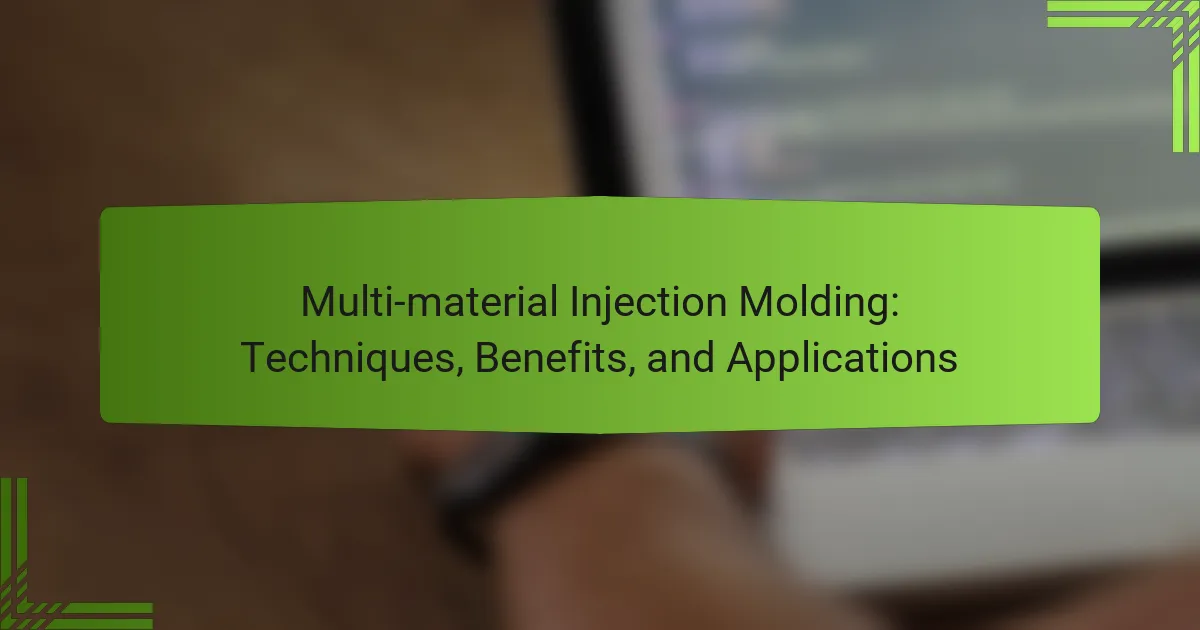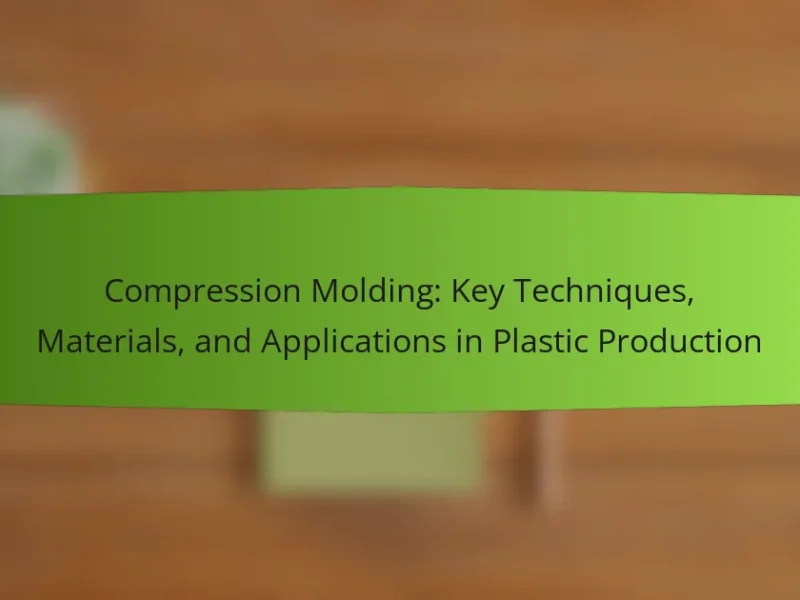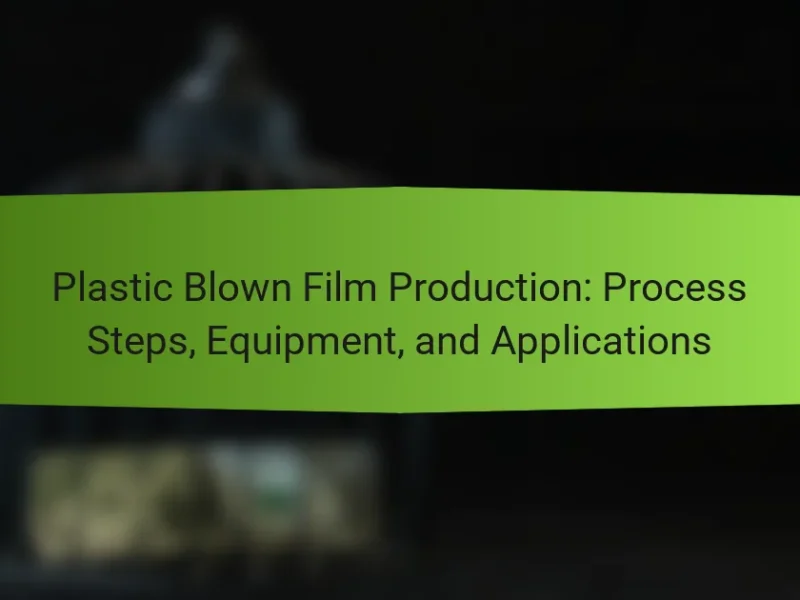Multi-material injection molding is a manufacturing process that integrates two or more distinct materials into a single component, enabling the production of complex geometries with enhanced functionality. This technique employs methods such as co-injection molding, insert molding, and overmolding, each serving specific purposes to improve product performance and design flexibility. Common applications span various industries, including automotive, consumer electronics, and medical devices, where it facilitates the creation of lightweight, durable products with improved aesthetics and reduced assembly costs. The article explores the techniques, benefits, and diverse applications of multi-material injection molding, highlighting its significance in modern manufacturing.

What is Multi-material Injection Molding?
Multi-material injection molding is a manufacturing process that combines two or more different materials into a single part. This technique allows for the creation of complex geometries and enhanced functionality. Multi-material injection molding can produce parts with varying colors, textures, and mechanical properties. The process typically involves multiple injection units working simultaneously or sequentially. This results in a final product that benefits from the unique attributes of each material used. Industries such as automotive, consumer goods, and medical devices frequently utilize this technology. Research shows that multi-material molding can improve product performance and reduce assembly costs.
How does Multi-material Injection Molding work?
Multi-material injection molding involves combining different materials in a single molding process. This technique uses specialized injection molding machines equipped with multiple injection units. Each unit injects a different material into the mold cavity, allowing for complex designs and varied material properties.
The process often starts with one material being injected, followed by a second material that adheres to the first. The mold temperature and pressure are carefully controlled to ensure proper bonding and prevent defects. Multi-material injection molding can produce parts with different colors, textures, and mechanical properties in one cycle.
This method is widely used in industries like automotive, consumer goods, and electronics to create lightweight and durable components. The efficiency of this process reduces production time and costs compared to traditional methods of combining materials.
What are the key processes involved in Multi-material Injection Molding?
The key processes involved in multi-material injection molding include material selection, mold design, injection sequence, and cooling. Material selection determines the types of polymers used in the process. Mold design must accommodate multiple materials and their interactions. The injection sequence dictates the order in which materials are introduced into the mold. Cooling processes are crucial for solidifying the materials properly. Each of these steps ensures that the final product meets desired specifications and performance criteria.
How does the material selection impact the outcome of Multi-material Injection Molding?
Material selection significantly impacts the outcome of multi-material injection molding. Different materials have unique properties that affect adhesion, flexibility, and strength of the final product. For instance, incompatible materials may lead to poor bonding, resulting in structural weaknesses. The choice of materials also influences the processing parameters, such as temperature and pressure, which can alter cycle times and production efficiency. Additionally, the thermal and mechanical properties of the selected materials dictate the usability of the molded parts in various applications. Studies indicate that proper material pairing enhances performance and durability, confirming the critical role of material selection in this manufacturing process.
What are the advantages of Multi-material Injection Molding?
Multi-material injection molding offers several advantages in manufacturing. It allows for the production of complex geometries with multiple materials in a single process. This technique enhances design flexibility, enabling the integration of different material properties into one part. It also reduces assembly time and costs by eliminating the need for multiple manufacturing steps. Additionally, multi-material injection molding can improve product performance through the combination of materials, such as rigid and flexible components. The process can lead to lighter products, as different materials can be optimized for weight reduction. Furthermore, it enhances aesthetic appeal by allowing for various colors and textures in one piece. These advantages make multi-material injection molding a preferred choice in industries like automotive and consumer goods.
How does Multi-material Injection Molding enhance product performance?
Multi-material Injection Molding enhances product performance by allowing the combination of different materials in a single part. This technique improves functionality by integrating various properties such as strength, flexibility, and aesthetics. It enables the creation of complex geometries that would be difficult to achieve with single-material molding. Additionally, it reduces assembly time and costs by consolidating multiple components into one. Research shows that products made through this process often exhibit better durability and performance characteristics. For example, products can be designed to have soft-touch surfaces while maintaining a rigid structure.
What cost benefits does Multi-material Injection Molding provide?
Multi-material Injection Molding provides significant cost benefits through reduced material waste and lower production costs. This technique allows for the use of multiple materials in a single process, minimizing the need for secondary operations. It streamlines manufacturing by combining multiple components into one part, which reduces assembly time and labor costs. Additionally, this method can lead to improved product performance, reducing the need for expensive materials. According to industry studies, companies can see a reduction in production costs by up to 30% when implementing multi-material techniques. This efficiency translates to faster time-to-market, further enhancing cost savings.
What industries utilize Multi-material Injection Molding?
Multi-material injection molding is utilized in various industries. Key industries include automotive, consumer electronics, medical devices, and packaging. The automotive industry uses this technique for producing complex parts with multiple materials. Consumer electronics benefit from multi-material components that enhance functionality and aesthetics. Medical devices require precision and biocompatibility, making this method ideal. Additionally, packaging industries leverage multi-material molding for creating innovative, lightweight, and functional designs. Each of these industries relies on multi-material injection molding for its versatility and efficiency in production.
Which specific applications benefit from Multi-material Injection Molding?
Multi-material Injection Molding benefits various applications. These include consumer electronics, automotive components, medical devices, and household goods. In consumer electronics, it allows for complex designs with different textures and colors. Automotive components utilize this technique for lightweight parts with integrated functionalities. Medical devices benefit from the ability to combine soft and rigid materials for enhanced usability. Household goods leverage multi-material molding for aesthetically pleasing and functional designs. Each application demonstrates the versatility and efficiency of multi-material Injection Molding in producing high-quality products.
How does Multi-material Injection Molding cater to the needs of different sectors?
Multi-material injection molding meets the diverse needs of various sectors by enabling the production of complex parts with multiple materials. This technique allows for the integration of different properties, such as flexibility and rigidity, in a single component. Industries like automotive benefit from lightweight, durable parts that enhance fuel efficiency. The consumer electronics sector utilizes this method to create aesthetically pleasing and functional devices. Medical applications leverage multi-material molding for producing intricate components that require precision and biocompatibility. According to a report by Research and Markets, the global multi-material injection molding market is projected to grow significantly, indicating its rising relevance across sectors. This growth is driven by the demand for innovative materials and designs that traditional molding cannot achieve.
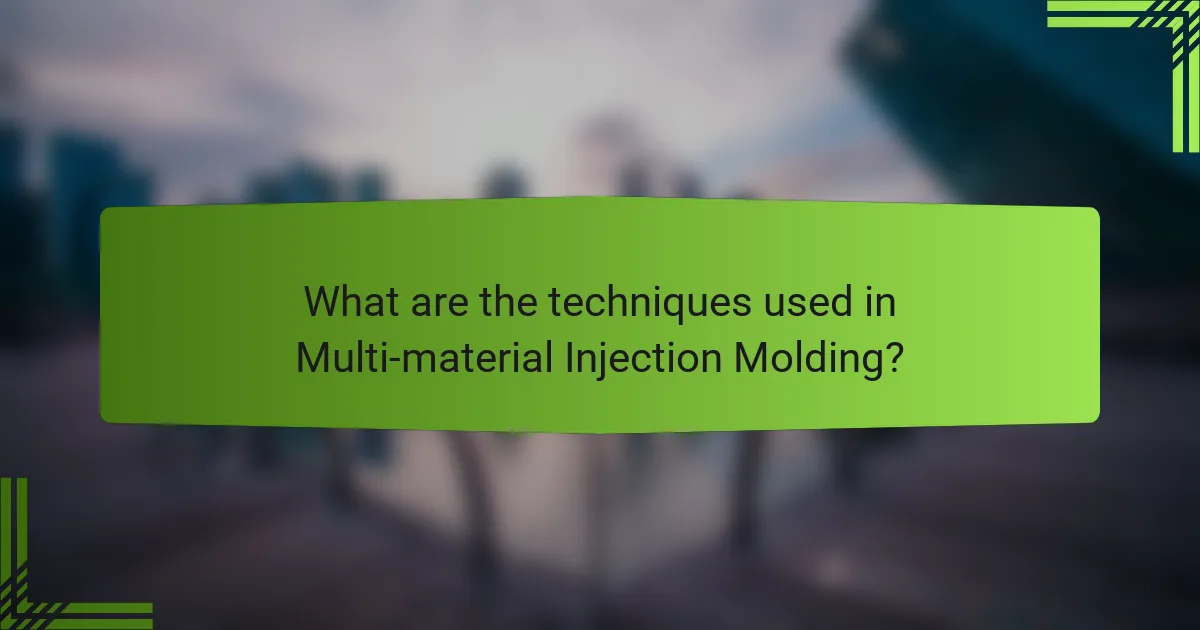
What are the techniques used in Multi-material Injection Molding?
The techniques used in multi-material injection molding include co-injection molding, insert molding, and overmolding. Co-injection molding involves injecting two different materials simultaneously into a single mold. This technique allows for the creation of complex parts with varying properties. Insert molding incorporates pre-formed components into the mold during the injection process. This adds strength and functionality to the final product. Overmolding involves applying a second material over a base material to enhance grip or aesthetics. Each technique serves specific purposes in enhancing product performance and design flexibility.
How do different injection molding techniques compare?
Different injection molding techniques vary primarily in their processes and applications. Conventional injection molding involves injecting molten plastic into a single mold. This method is efficient for producing large quantities of identical parts. In contrast, multi-material injection molding allows for the combination of different materials in a single part. This technique enables the creation of complex components with varied properties.
Another technique is gas-assisted injection molding. This method uses gas to create hollow parts, reducing material usage and weight. It is particularly useful for large, thin-walled products. Furthermore, insert molding integrates metal or other components into the plastic part during the injection process. This technique enhances the strength and functionality of the final product.
Each technique has its specific advantages. Conventional molding is cost-effective for high-volume production. Multi-material molding offers design flexibility and improved product performance. Gas-assisted molding reduces material costs and enhances product durability. Insert molding improves part integrity through the combination of materials. These factors contribute to the selection of a specific injection molding technique based on project requirements.
What is the significance of co-injection molding in Multi-material Injection Molding?
Co-injection molding is significant in multi-material injection molding because it allows for the simultaneous injection of two or more materials. This technique enhances product functionality by combining different material properties. For example, a hard outer shell can be combined with a soft inner core. This results in products that are both durable and comfortable to use. Co-injection molding also reduces material waste by optimizing the use of resources. It enables complex part designs that would be difficult with single-material processes. Furthermore, it can improve production efficiency and reduce cycle times. Overall, co-injection molding expands the possibilities for innovative and high-performance products in various industries.
How does overmolding contribute to Multi-material Injection Molding processes?
Overmolding enhances Multi-material Injection Molding processes by allowing the combination of different materials in a single part. This technique enables the creation of complex geometries and improved product functionality. Overmolding can provide better grip, cushioning, and aesthetics. Additionally, it allows for the integration of soft and hard materials, improving user experience. The process increases manufacturing efficiency by reducing the number of assembly steps. Studies show that overmolding can significantly reduce production costs. It also enhances the durability and performance of the final product. Overall, overmolding is a critical technique in optimizing multi-material applications.
What innovations are shaping Multi-material Injection Molding techniques?
Innovations shaping multi-material injection molding techniques include advancements in materials, machinery, and processing methods. New materials, such as bio-based and recycled polymers, enhance sustainability. Improved machinery features like enhanced control systems increase precision and efficiency. Developments in processing methods, such as co-injection and overmolding, enable complex geometries and better material bonding. Integration of Industry 4.0 technologies, like IoT and automation, streamlines production and reduces waste. Research indicates that these innovations lead to reduced cycle times and improved product quality.
How are advancements in technology influencing Multi-material Injection Molding?
Advancements in technology are significantly influencing multi-material injection molding by enhancing precision and efficiency. Innovations such as improved software for simulation and design streamline the molding process. Advanced materials, including high-performance thermoplastics, enable better product performance. Automation technologies, like robotics, increase production speed and reduce labor costs. Additionally, the integration of IoT devices allows for real-time monitoring and data analysis. This leads to optimized production and reduced waste. The use of additive manufacturing in mold creation also shortens lead times. These technological advancements collectively improve the overall quality and capabilities of multi-material injection molding.
What role do automation and robotics play in Multi-material Injection Molding?
Automation and robotics enhance efficiency in multi-material injection molding. They streamline the production process by reducing cycle times. Automated systems ensure precise control over material placement and temperature settings. Robotics facilitate the handling of complex multi-material components. This leads to improved product quality and consistency. According to a study by the Society of Plastics Engineers, automation can increase production rates by up to 30%. Additionally, robotics minimize human error and labor costs. Overall, automation and robotics are integral for optimizing multi-material injection molding operations.
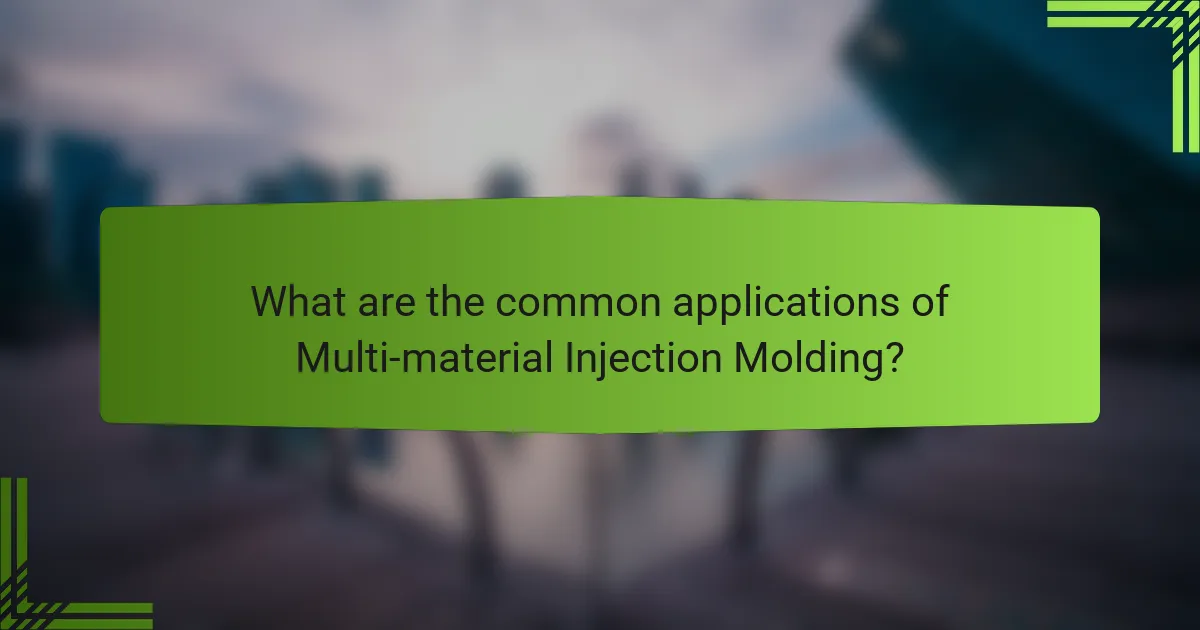
What are the common applications of Multi-material Injection Molding?
Common applications of multi-material injection molding include automotive parts, consumer electronics, and medical devices. In automotive manufacturing, it is used to create complex components like dashboards and door panels. Consumer electronics benefit from multi-material molding for producing items such as smartphone cases and remote controls. Medical devices utilize this technology for items like syringes and surgical instruments. This method allows for enhanced functionality, improved aesthetics, and reduced assembly time. The versatility of multi-material injection molding supports the production of lightweight and durable products across various industries.
How is Multi-material Injection Molding used in consumer products?
Multi-material injection molding is used in consumer products to create complex parts with multiple materials in a single process. This technique allows for the integration of different properties, such as rigidity and flexibility, into one product. Common applications include toothbrushes, where hard plastic and soft rubber are combined for comfort and functionality. It is also utilized in the production of electronic housings, enabling better ergonomics and aesthetic appeal. The process enhances product performance by allowing for better sealing and insulation. Multi-material injection molding reduces assembly time and costs by producing parts that would otherwise require multiple manufacturing steps. This method is increasingly popular due to its efficiency and ability to meet diverse consumer needs.
What examples illustrate the effectiveness of Multi-material Injection Molding in electronics?
Multi-material injection molding is effective in electronics through various applications. One example is the production of smartphone housings that integrate multiple materials for enhanced durability and aesthetics. This technique allows for the combination of rigid and flexible materials in a single part, improving user experience. Another example is the creation of complex electronic connectors that require both insulation and conductivity. Multi-material injection molding enables precise placement of materials, ensuring optimal performance. Additionally, components like circuit boards can be manufactured with integrated features, reducing assembly time and improving reliability. These instances demonstrate the versatility and efficiency of multi-material injection molding in the electronics sector.
How does Multi-material Injection Molding enhance automotive components?
Multi-material injection molding enhances automotive components by allowing the integration of different materials into a single part. This technique improves the performance and functionality of automotive components. It enables the combination of materials with varying properties, such as rigidity and flexibility. As a result, components can be lighter and more durable. Multi-material molding also reduces assembly time and costs. According to a study by the Society of Automotive Engineers, this process can decrease production time by up to 30%. Additionally, it allows for complex geometries that traditional molding cannot achieve. This innovation leads to more efficient designs and improved aesthetics in automotive parts.
What future trends are expected in Multi-material Injection Molding applications?
Future trends in multi-material injection molding applications include increased automation and the use of advanced materials. Automation enhances production efficiency and reduces labor costs. Advanced materials, such as biodegradable plastics and composites, are gaining popularity due to environmental concerns.
Additionally, the integration of Industry 4.0 technologies is expected to improve process monitoring and control. This integration allows for real-time data analysis, leading to better quality assurance. The demand for lightweight components in automotive and aerospace sectors drives innovation in this field.
Furthermore, customization and personalization of products will become more prevalent. This trend caters to consumer preferences for unique designs. Finally, sustainability practices will shape future developments, as companies seek to minimize waste and energy consumption.
How is sustainability influencing Multi-material Injection Molding applications?
Sustainability is significantly influencing Multi-material Injection Molding applications by driving the adoption of eco-friendly materials. Manufacturers are increasingly using biodegradable and recyclable polymers to reduce environmental impact. This shift aligns with global sustainability goals aimed at minimizing waste and carbon emissions. Multi-material Injection Molding allows for the combination of these sustainable materials in a single process. The technology also supports lightweight design, which enhances energy efficiency in product use. According to a study by the American Society of Mechanical Engineers, sustainable practices in manufacturing can lead to a 30% reduction in material waste. This evidence underscores the positive impact of sustainability on the evolution of Multi-material Injection Molding.
What emerging markets are adopting Multi-material Injection Molding technologies?
Emerging markets adopting Multi-material Injection Molding technologies include India, Brazil, and Vietnam. These countries are increasingly investing in advanced manufacturing techniques. For instance, India’s manufacturing sector is projected to grow significantly, with multi-material technologies enhancing product design and functionality. Brazil is focusing on sustainable practices, utilizing multi-material molding to reduce waste and improve efficiency. Vietnam’s rapid industrialization supports the adoption of innovative manufacturing technologies to meet global supply chain demands. These trends indicate a shift towards advanced production methods in these regions.
What best practices should be followed in Multi-material Injection Molding?
Use precise material selection for multi-material injection molding to ensure compatibility. This prevents issues like delamination and enhances product integrity. Maintain optimal processing conditions, such as temperature and pressure, for each material used. This ensures proper flow and bonding between materials. Implement effective mold design to accommodate different materials and their unique flow characteristics. This reduces cycle time and improves efficiency. Conduct thorough testing and quality control throughout the process. This identifies defects early and maintains product standards. Collaborate with suppliers for material insights and advancements. This can lead to innovative solutions and improved performance. Regularly train staff on best practices and new technologies. This keeps the team updated and enhances operational efficiency.
Multi-material injection molding is a manufacturing process that integrates two or more materials into a single component, enhancing design complexity and functionality. The article covers the operational mechanics of this technique, including material selection, mold design, and the key processes involved. It highlights the advantages of multi-material injection molding, such as improved product performance, reduced assembly costs, and increased aesthetic appeal across various industries, including automotive, consumer goods, and medical devices. Additionally, the article discusses the impact of advancements in technology, sustainability trends, and best practices for optimizing multi-material injection molding applications.
